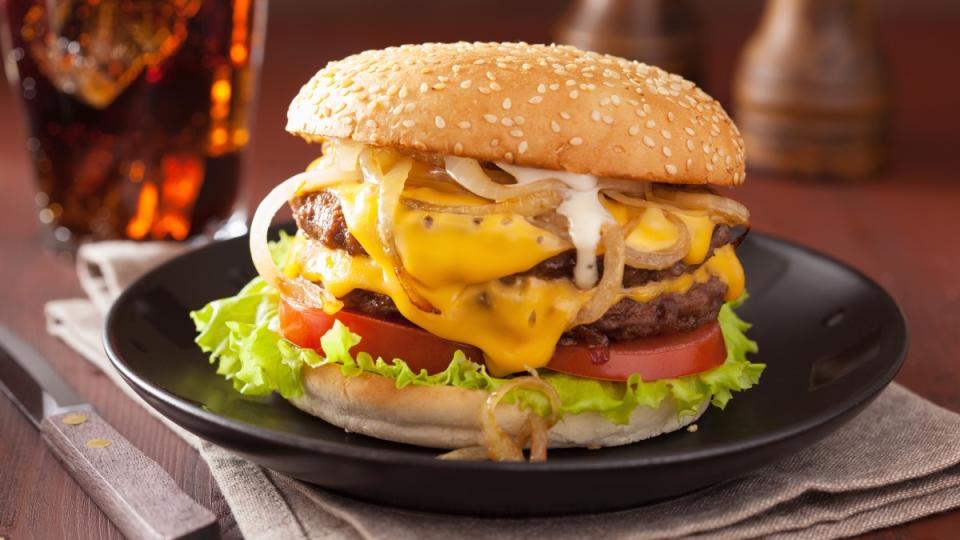MD: You Can Get the Weight Loss Benefits of Injectables *Without* the Side Effects
Whether you’re searching for a way to outsmart diabetes or seeking a solution for stubborn weight gain, look no further: A hormone called GLP-1 (glucagon-like peptide 1) has a powerful ability to lower blood sugar and melt unwanted pounds. In fact, it’s the reason "miracle" drugs like Ozempic and Wegovy have skyrocketed in popularity.
But taking the medications — if you can even get them amid shortages — can run you up to $2400 a month. Plus, they can trigger unwelcome side effects such as nausea, diarrhea and fatigue. And, if you're a food lover, it's tough to take a medication that robs you of the pleasure of eating. The good news: Experts say people who prefer drug-free GLP-1 alternatives have plenty of natural options that deliver all the benefits without the GI upset.
The benefits of increasing GLP-1 levels
Produced primarily in the intestines, GLP-1 is a hormone that prods the pancreas to produce blood sugar-balancing insulin. That’s a clear benefit when it comes to outsmarting diabetes. Indeed, findings from the National Research Institute reveal lifting levels of GLP-1 can lower A1C readings (a measurement of average blood glucose levels) by nearly two points. It's also a boon for weight loss, since excess blood glucose gets stored as fat. Plus, by preventing the blood sugar spikes and swings that trigger food cravings, GLP-1 helps dieters stay on track.

That's not all GLP-1 does. It also safeguards against blood sugar surges and the dips that follow. How? It suppresses release of glucagon, a hormone that signals the liver to send the glucose it contains into circulation. In addition, GLP-1 slows the rate at which food moves through the stomach and intestines. The result: you feel fuller and more satisfied after eating. What's more, a study in the journal Molecular Psychiatry reveals GLP-1 sends hunger-taming signals to the hypothalamus, the brain region that’s been dubbed the "master regulator" of satiety.
Finally, GLP-1 increases production of brown fat (also known as brown adipose tissue) in the body, say researchers reporting in the journal Diabetes. That’s key, since brown fat boosts fat-burning and metabolism. This makes it markedly easier to melt stubborn pounds. (Click through for more ways to activate your body's brown fat.)
Why GLP-1 boosters have taken the weight-loss world by storm
The active ingredient in both Ozempic and Wegovy is called semaglutide and belongs to a class of drugs known as GLP-1 agonists. Similar in chemical structure to the GLP-1 produced in the body, it was originally approved by the FDA as Ozempic, an injectable diabetes treatment. But people who used it enjoyed more than blood sugar reductions: They experienced weight loss on par with bariatric surgery. And in a New England Journal of Medicine study, adults on the drug dropped 489% more weight than those who received placebo injections.
Following Ozempic's success, the FDA approved semaglutide for weight loss under a second brand name (and a higher dose). Called Wegovy, it quickly soared in popularity. But the drug’s manufacturer had supply-chain issues, so people stared slimming with "off-label"Ozempic instead. Hollywood A-listers were rumored to use it to stay trim, and demand skyrocketed. In fact, people with diabetes struggled to find Ozempic due to the weight loss craze.
Those who should consider GLP-1 injectables
Semaglutide isn’t for everyone. According to Katrina Ubell, MD, host of the podcast Weight Loss for Busy Physicians, it can be a “godsend” or some, “but it’s not meant for someone who just has those last 20 pounds to lose.” And as Amy Shah, MD, points out, the drugs aren’t intended for people who can lose weight by adopting healthy lifestyle and diet measures.
So who is semuglutide designed for? People with a body mass index (BMI) of greater than 30, or a BMI of 27 or more plus a weight-related health issue such as type 2 diabetes, high blood pressure or high cholesterol. Those criteria are set for health insurance purposes. (Click through to discover small lifestyle tweaks that help reverse prediabetes.)
(For more information on injectables, click through our sister publication's story: Ozempic for Women Over 50? 5 Doctors Weigh In on the New Weight-Loss Injectables)
The downsides of weight loss injectables
For all that semuglutide can do, the drug does have its downsides. Wegovy and Ozempic have to be injected on a regular basis. And while costs (usually around $1,200 per month) are covered by most insurance plans for diabetes, you may have to pay out-of-pocket for weight loss purposes. Same goes for Rybelsus, a pill form of semuglutide that’s approved for treating diabetes but can be used off-label for weight loss. (For more on Rybelsus, click through to Rybelsus vs Ozempic.)
The medications can also trigger side effects that include nausea, diarrhea and fatigue. Plus, they carry potential risks of thyroid tumors, cancer, pancreatitis and gallbladder and kidney problems. What's more, the weight you've lost can come back when you stop taking the drug. Researchers reporting in Diabetes, Obesity and Metabolism found people who discontinued Wegovy regained two-thirds of lost weight within one year.
The best natural GLP-1 alternatives
GLP-1 agonists can be an inspiration for anyone hoping to drop excess pounds, notes Columbia University–trained nutrition expert Fred Pescatore, MD. And in welcome news, he adds, “It’s easy to mimic the effects of the medications without their drawbacks.” Here, the simple strategies that boost GLP-1 naturally.
Make breakfast your biggest meal of the day
Love indulging in a hearty breakfast? Go ahead and enjoy! A study in the journal Diabetologia found that when people consumed a generous breakfast and a light dinner, their GLP-1 levels were 30% higher than when they reversed the pattern. The body’s circadian clock triggers a natural GLP-1 uptick in the morning. That means eating ample morning calories optimizes GLP-1 release all day by working in sync with your internal timekeeper. (Click through to see how a protein-rich breakfast like proffee speeds weight loss.)

Switch up your sweetener
Sure, sipping beverages that contain "fake sugars" such as sucralose and acefsulfame-K will save you some calories . But as Dr. Pescatore points out, it will also block your body’s ability to produce GLP-1. In fact, one study found ingesting the artificial sweeteners daily lowered folks’ GLP-1 levels by 35% within two weeks. Instead, Dr. Pescatore recommends stirring a low-calorie option called allulose into lemonade, coffee and tea. Experts reporting in Food Science and Technology Research found the sweetener lifted women’s GLP-1 by 70% in 1 hour. One to try: Rx Sugar Allulose (Buy from Walgreens.com, $9.99). (Click through to see how one woman made weight loss effortless by switching to allulose sweetener.)
Drizzle EVOO over your favorite dishes
Using olive oil in marinades, dressings and veggie dishes boosts more than flavor: Researchers reporting in the American Journal of Clinical Nutrition found enjoying 3 to 4 Tbs. of the oil in place of butter increased GLP-1 43% within a single day. The monounsaturated fatty acids found in olive oil spur an uptick in GLP-1 release. And the polyphenol compounds it contains blunt the breakdown of the hormone in the body. Tip: Opt for extra virgin olive oil whenever possible. In a study published in the journal Nutrients, it proved 63% higher in polyphenols than refined olive oil.
Challenge friends to a game of pickleball
Or dance in your living room. Moving your muscles activates the sympathetic nervous system to stimulate GLP-1 release. And in an International Journal of Preventive Medicine study, folks who got three hours of exercise weekly for 12 weeks experienced increases in GLP-1 that were 733% greater than their less-active counterparts. Dr. Pescatore advises engaging in fun activities like dancing, bicycling, badminton or pickleball for 20 to 30 minutes daily. “The key is to choose something you enjoy — that way, you’ll do it gladly rather than dreading it,” he says. (Click through to see why fitness legend Denise Austin loves pickleball.)

Make green veggies your go-to
Vegetables such as broccoli, Brussels sprouts and cabbage activate bitter taste receptors in the gut, which stimulates GLP-1 release. Plus, the veggies’ natural fiber slows stomach emptying , another way drugs such as Ozempic support slimming. Dr. Shah says, “If you eat these vegetables with two meals a day, you’ll change your body in ways you’d never imagine.”
Structures called thylakoids found in leafy greens also have a study backed ability to lift GLP-1. In fact, findings in the journal Appetite suggest enjoying ? cup of leafy greens such as spinach, kale and collards increases GLP-1 by 250% within 30 minutes. And as a result, cravings for sweets drop by 93% for up to three hours . Experts explain thylakoids inhibit the activity of pancreatic lipase, an enzyme that blunts GLP-1 release. (Click through to learn more about the health benefits of leafy greens.)
Savor a cheeseburger for dinner
Or enjoy chicken parm. "Protein-rich foods such as beef and chicken nourish intestinal cells that produce GLP-1, as does the calcium in cheese,” explains Dr. Pescatore. That’s why research in Advances in Nutrition suggests eating meat and cheese raises GLP-1 by 300% in just 90 minutes. The tasty way to get the benefits: Aim for at least two servings of beef, poultry, fish and eggs paired with two servings of cheese daily.

Consider a berberine boost
Experts have long known that berberine, a compound derived from plants such as Indian barberry, goldenseal, and Oregon grape, has an impressive ability to balance blood sugar. And findings in the journal Nutrition and Diabetes suggest supplementing with berberine can optimize GLP-1 levels within 8 weeks. The compound defends cells that secrete GLP-1 against damage that can sabotage production of the hormone. The dose Dr. Pescatore recommends: 500 mg., three times daily. One to try: Solaray Vital Extracts Berberine 500 mg. (Buy from iHerb.com, $19.99). (Click through to learn more about berberine, which has been dubbed "nature's Ozempic".)
Add a dash of cinnamon to desserts
Good news for cinnamon lovers: Enjoying 1 tsp. of the spice can lift GLP-1 levels by 89% for 2 1/2 hours. So say researchers reporting in The American Journal of Clinical Nutrition, who note cinnamon stimulates L-cells in the gut that produce the hormone. Folks in the study stirred cinnamon into rice pudding, but it also makes a great addition to fresh fruit and yogurt parfaits.
Read on to learn more about weight loss injectables and if they're right for you:
Don’t Be Envious of Celebs Taking Ozempic for Weight Loss — Here Are 8 Bad Side Effects
Ozempic for Women Over 50? 5 Doctors Weigh In on the New Weight-Loss Injectables
This content is not a substitute for professional medical advice or diagnosis. Always consult your physician before pursuing any treatment plan.
A version of this article originally appeared in our print magazine, Woman's World.
Woman's World aims to feature only the best products and services. We update when possible, but deals expire and prices can change. If you buy something via one of our links, we may earn a commission.
Questions? Reach us at [email protected]
